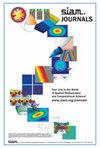Learning Sparsity-Promoting Regularizers Using Bilevel Optimization
IF 2.3
3区 数学
Q3 COMPUTER SCIENCE, ARTIFICIAL INTELLIGENCE
引用次数: 0
Abstract
SIAM Journal on Imaging Sciences, Volume 17, Issue 1, Page 31-60, March 2024.Abstract. We present a gradient-based heuristic method for supervised learning of sparsity-promoting regularizers for denoising signals and images. Sparsity-promoting regularization is a key ingredient in solving modern signal reconstruction problems; however, the operators underlying these regularizers are usually either designed by hand or learned from data in an unsupervised way. The recent success of supervised learning (e.g., with convolutional neural networks) in solving image reconstruction problems suggests that it could be a fruitful approach to designing regularizers. Towards this end, we propose to denoise signals using a variational formulation with a parametric, sparsity-promoting regularizer, where the parameters of the regularizer are learned to minimize the mean squared error of reconstructions on a training set of ground truth image and measurement pairs. Training involves solving a challenging bilevel optimization problem; we derive an expression for the gradient of the training loss using the closed-form solution of the denoising problem and provide an accompanying gradient descent algorithm to minimize it. Our experiments with structured 1D signals and natural images indicate that the proposed method can learn an operator that outperforms well-known regularizers (total variation, DCT-sparsity, and unsupervised dictionary learning) and collaborative filtering for denoising.
利用双层优化学习稀疏性促进正则表达式
SIAM 影像科学杂志》,第 17 卷第 1 期,第 31-60 页,2024 年 3 月。 摘要我们提出了一种基于梯度的启发式方法,用于监督学习用于去噪信号和图像的稀疏性促进正则化。稀疏性促进正则化是解决现代信号重建问题的关键要素;然而,这些正则化的基本算子通常要么是手工设计的,要么是以无监督的方式从数据中学习的。最近,监督学习(如卷积神经网络)在解决图像重建问题方面取得了成功,这表明监督学习可能是设计正则化器的一种富有成效的方法。为此,我们建议使用参数化、稀疏性促进正则器的变分公式对信号进行去噪,其中正则器参数的学习是为了最小化在一组基本真实图像和测量对的训练集上重建的均方误差。训练涉及解决一个具有挑战性的双层优化问题;我们利用去噪问题的闭式解推导出了训练损失梯度表达式,并提供了一种相应的梯度下降算法来最小化训练损失。我们用结构化一维信号和自然图像进行的实验表明,所提出的方法可以学习一种算子,其性能优于众所周知的正则化器(总变异、DCT-稀疏性和无监督字典学习)以及用于去噪的协同过滤。
本文章由计算机程序翻译,如有差异,请以英文原文为准。
求助全文
约1分钟内获得全文
求助全文
来源期刊

SIAM Journal on Imaging Sciences
COMPUTER SCIENCE, ARTIFICIAL INTELLIGENCE-COMPUTER SCIENCE, SOFTWARE ENGINEERING
CiteScore
3.80
自引率
4.80%
发文量
58
审稿时长
>12 weeks
期刊介绍:
SIAM Journal on Imaging Sciences (SIIMS) covers all areas of imaging sciences, broadly interpreted. It includes image formation, image processing, image analysis, image interpretation and understanding, imaging-related machine learning, and inverse problems in imaging; leading to applications to diverse areas in science, medicine, engineering, and other fields. The journal’s scope is meant to be broad enough to include areas now organized under the terms image processing, image analysis, computer graphics, computer vision, visual machine learning, and visualization. Formal approaches, at the level of mathematics and/or computations, as well as state-of-the-art practical results, are expected from manuscripts published in SIIMS. SIIMS is mathematically and computationally based, and offers a unique forum to highlight the commonality of methodology, models, and algorithms among diverse application areas of imaging sciences. SIIMS provides a broad authoritative source for fundamental results in imaging sciences, with a unique combination of mathematics and applications.
SIIMS covers a broad range of areas, including but not limited to image formation, image processing, image analysis, computer graphics, computer vision, visualization, image understanding, pattern analysis, machine intelligence, remote sensing, geoscience, signal processing, medical and biomedical imaging, and seismic imaging. The fundamental mathematical theories addressing imaging problems covered by SIIMS include, but are not limited to, harmonic analysis, partial differential equations, differential geometry, numerical analysis, information theory, learning, optimization, statistics, and probability. Research papers that innovate both in the fundamentals and in the applications are especially welcome. SIIMS focuses on conceptually new ideas, methods, and fundamentals as applied to all aspects of imaging sciences.
 求助内容:
求助内容: 应助结果提醒方式:
应助结果提醒方式:


